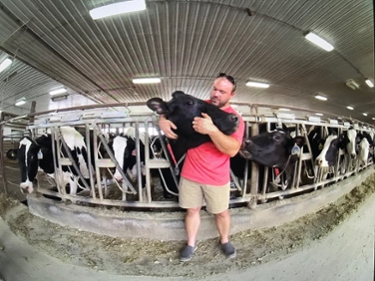Bringing the Farm to the Classroom with Virtual Reality
Southwest Minnesota State University
 Background
Background
At Southwest Minnesota State University (SMSU), students travel to farms many miles from the university to gain valuable farm experience. Unfortunately, weather hazards or other challenges make these visits impossible, leading to missed learning opportunities that cannot be rescheduled. Through the use of virtual reality technology, SMSU is bringing the farm to the classroom, offering an alternative way to engage the farm experience. These experiences either compliment or act as an incidental replacement for farm-based learning opportunities.
SMSU’s first Introduction to Animal Science course was taught in the fall of 2018. An important component of the course was visits to various kinds of farm operations, e.g. hogs, poultry, and dairy. We encountered several challenges to providing these field experiences for our students: weather and student schedules in particular.
Most animal science programs are located at larger, RI institutions that are more established, have on-site facilities and animals, and, in general, more resources. We cannot compete with them at the same level. Our goal is to level the playing field as much as possible, giving SMSU students some of the same opportunities, but providing them in a way that leverages technology and is more relevant to our curriculum.
The focus at SMSU is sustainable agriculture. The goal of the animal science course is to introduce students to where food comes from by bringing what actually goes on at farms to the classroom. Many of our students did not grow up on farms and are not planning to go into farming. Rather, they are pursuing agriculture-related fields that require familiarity, rather than deep knowledge and experience, of raising animals. These programs include: Agribusiness Management, Agricultural Education, Agricultural Communication and Leadership, Culinology, and Hospitality Management (the SMSU School of Agriculture has a “farm to fork” curriculum). In addition to students in agriculture-related majors, the fall class included several Culinology and pre-vet students.
Students in the School of Agriculture are already using technology, including images and videos of their own farms and social media. We wanted to further leverage technology to extend their experiences. VR enables us to provide “virtual visits” to innovative farms, especially those at a distance, and to use a combination of VR and travel to local farms as lab experiences.
A media production company in Minneapolis, Visual, produced our VR experiences. They filmed three different types of farms, did the post-production work, and downloaded 6 “experiences” onto 4 Oculus Go headsets we had purchased. Each student is in their own “world,” enabling total immersion in the experience. This is not ideal for a classroom setting, where students need to process their experiences together to make the most of the activity. The solution: Visual has developed their own platform that enables us to synchronize the content among all the headsets, enabling those critical group experiences.
With this synchronized VR content, we can bring the farm to the classroom. Students are able to experience different parts of each of the farms, as well as their design and layout. They can go inside the buildings, see the animals and how they interact with their environment, handlers, and each other. They can watch as modern technology provides new ways to feed, birth, and raise the animals, as well as to manage their waste. One of the farms we filmed was a “robot dairy farm.” A camera has the potential to record things that a student wouldn’t be able to experience on an actual tour, such as the birth of piglets or a calf (we filmed both!). Some farms, especially swine facilities, do not allow tours because of biosecurity concerns. With VR, we were able to visit farms based on the curriculum, not distance from campus. Once students are “on the virtual farm,” they can explore the environment by looking up, down, and turning around.
Type of Grant Received through Minnesota State Innovation Funding
Large Seed Grant – $25,000- Virtual Reality Enhances Ag Programs; More VR Projects to Come - SMSU News
- Innovation Expo Presentation at the 2021 Shark Tank Open
360 degree previews of farms:
Contact
Minnesota State faculty, staff, and administrators interested in applying for an innovation funding grant can visit the Innovation Funding SharePoint (log in using StarID@MinnState.edu) to find more information and applications.